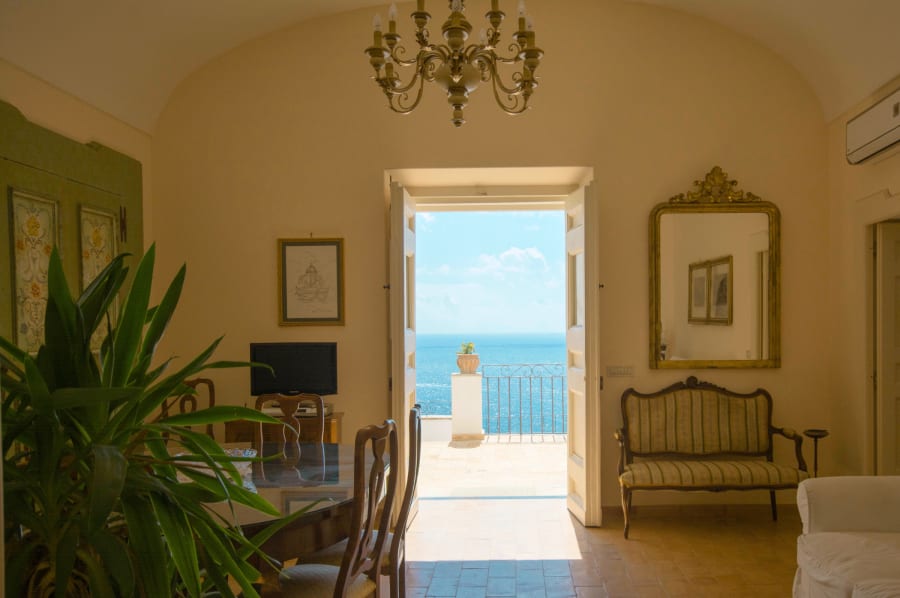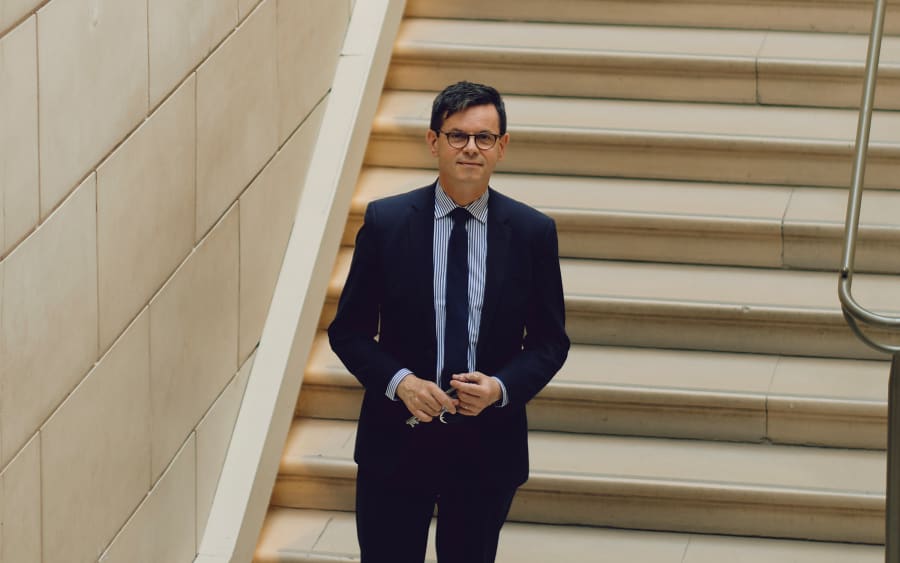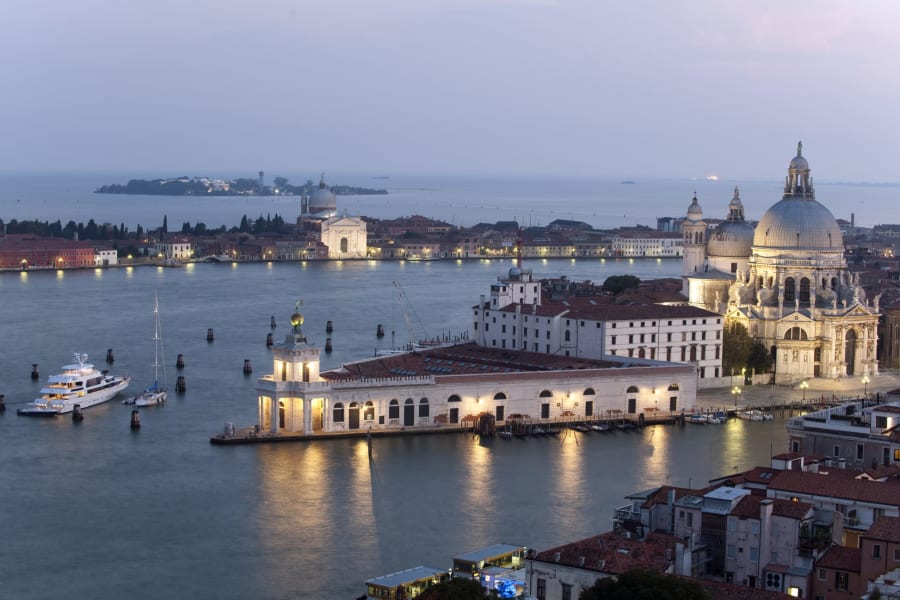It’s never been difficult to convince collectors, curators, and critics to visit Venice. While plenty of other cities have tried to replicate its format and magic, the Venice Biennale, founded in 1895, remains one of the most important art exhibitions in the world, attracting more than 700,000 visitors to its most recent edition. Since 1980, the Venice Architecture Biennale has run in the off years, becoming a major draw in its own right.
For a long time, many of the Venetian palaces that hosted parties, exhibitions, and shows returned to a silent slumber once the respective biennales wound down, lying dormant until the next editions. The day-trippers pacing the calli (lanes) were none the wiser to the treasures lying behind their closed doors, and the city’s contemporary art credentials remained largely under wraps, drowned out by its well-established historical wonders. But in recent years, Venice has developed into a year-round contemporary art capital as more and more galleries, foundations, and institutions have permanently settled into the city’s labyrinth of canals and narrow alleys (and, it must be said, as the lines between art and architecture exhibitions blur).
Why now? ‘In a literal and metaphorical sense, Venice has always been the trait d’union between east and west,’ says Mario Codognato, the director of Berggruen Arts & Culture, explaining why the foundation chose the city for its European HQ. Set up by US-based philanthropist Nicolas Berggruen, the foundation runs two venues in Venice: one, the home of its think tank, opened in 2023 inside the neo-Gothic Casa dei Tre Oci on Giudecca island; the latest, Palazzo Diedo, debuted as an exhibition space in 2024, in an extensively renovated 18th-century building in the Cannaregio district. Alongside its opening show, the venue presented 11 site-specific installations by stars like Carsten Höller, Ibrahim Mahama, and Sterling Ruby; its upcoming exhibition, ‘The Next Earth. Computation, Crisis, Cosmology’, will run parallel to the architecture biennale as an official satellite event.
The palace’s programming is closely tied to the activities of both biennales, with one major show lasting for several months. For Codognato, that’s not a limitation. ‘To me, the factor which spearheaded [the current growth in Venetian venues] is the biennale’s enlightened decision to extend its duration from April to November,’ he says. In 2013, the art event reverted to its original opening month of April after years of opening in June: The current timing turns it into a nine-month affair. The architecture event runs for almost as long. ‘This has led many people who are interested in art at many different levels to spend long periods in the city, which has contributed to creating a milieu that didn’t exist before,’ says Codognato.
In the Encounters sector, dedicated to large-scale installations, Kim’s gallery reintroduced the late Filipino artist Pacita Abad’s practice to an Asian audience with Through the Looking Glass (1996); the monumental installation sold to a museum in Southeast Asia for USD 500,000. Also in Encounters, three works by the First Nations artist Betty Muffler were sold by Ames Yavuz (Singapore, Sydney, London), all in the range of USD 40,000–60,000, and Property Holdings Development Group (Hong Kong) sold a piece by Christopher K. Ho to a major corporate collection. De Sarthe (Hong Kong), meanwhile, saw great success with NFTs and editions by the Chinese artist Lu Yang’s digital alter ego, Doku. The acquisition of Yang’s all-encompassing Encounters installation – DOKU the Creator (2025) – was being negotiated, with multiple institutions expressing strong interest, but the sale had not yet been confirmed at the time of publication.
Despite some trepidation in the international market, sales to institutions and collections abroad made a strong return this year. The Chinese space Star Gallery (Beijing) sold Zhang Wei’s oil-on-paper Jingshan Front Street, Beijing (1974) for USD 11,050 to the Tate Modern. San Francisco’s Jessica Silverman gallery sold two new pieces by the Indian artist Rupy C. Tut for USD 40,000 each, with one going to a Bay Area institution. And the Bologna gallery P420 sold five historical works by the German Italian artist Irma Blank to private collections in Hong Kong, China, Italy, Germany, and Colombia, with prices ranging from USD 8,500 to USD 32,000.
She and her husband, Agostino, bought the island of San Giacomo in Paludo – previously a monastery and, later, a gunpowder warehouse – in 2018: There, they staged performances by Brazil-born Jota Mombaça and Korean artist Eun-Me Ahn during the art biennale’s openings in 2022 and 2024 respectively. Re Rebaudengo believes the city’s inexhaustible mystique, its wealth of classic masterpieces (including jaw-dropping works by Tintoretto), and the lagoon’s aquatic charm are the enduring reasons behind its renewed appeal. ‘It’s becoming a city for looking, thinking, learning, building – an increasingly lively and interesting place,’ she adds.
Now commercial galleries, too, are reaching critical mass – especially international ones. In 2024, Almine Rech mounted a pop-up space inside the terracotta-hued Palazzo Cavanis. The same year, Rome’s Lorcan O’Neill, Milan’s Tommaso Calabro, and Berlin’s Wentrup all decamped here on a more permanent basis – the latter occupying the light-filled former studio of fashion designer Giuliana Camerino. Italian dealer Michele Barbati spent his formative years in Venice and, after a long stint in Los Angeles, returned to open his own venture in 2022, not far from the stately Gallerie dell’Accademia; meanwhile, London-born Victoria Miro has been operating a Venice outpost even longer, since 2017. Though the pressures of overtourism are pushing rents up (famously squeezing many residents out of the city center), for galleries, Venice is not necessarily a more expensive dream than London, New York, or Paris.
‘We came to Venice because we wanted somewhere that wasn’t a faceless megacity,’ says Treviso-born Marta Barina, the founder of multidisciplinary gallery and production studio Mare Karina. Barina lived and worked for major players in London for ten years before returning to Italy. After operating as a nomadic entity for a few years, the gallery settled in Venice near the Arsenale in 2024. It’s a space that, she says, is affordable enough to allow her to focus on ‘research’ and a ‘riskier’ program. ‘Venice is a hyper-local city with a tight-knit community but, at the same time, it has an international audience who come here to experience art,’ she says, explaining how her program focuses on emerging artists and fosters links with the local context. ‘It’s not a competitive place – there is an emphasis on cooperation, also between writers, artists, gallerists, collectors, and residents.’
And artists do love to exhibit here, some so much that they have relocated: British artist Anish Kapoor now works from a studio in Venice and has acquired Palazzo Manfrin, where he has already staged a colossal exhibition of his work. Irish artist Michael Craig-Martin also has a Venetian perch. As for a younger generation of practitioners, the local university has an excellent reputation for creative disciplines; whether artists and curatorial graduates stick around and make Venice into a place for production depends on real estate’s affordability and the willingness of this evolving ecosystem to work with the grassroots end of the art spectrum.
The San Marco Art Centre (SMAC), which opens on May 9, hopes to be able to do just that. Located within the Procuratie Vecchie – the multilayered, arch-lined building flanking Piazza San Marco, which was recently refurbished by architect David Chipperfield – its setting is nothing short of spectacular. Yet, its co-founders – Anna Bursaux, David Gramazio, and David Hrankovic – hope to run this multidisciplinary culture center in a way that, in their words, is ‘spontaneous’, ‘fresh,’ and ‘experimental.’ ‘We’re trying to slowly contribute to creating that microbiome in which artists and their practices flourish,’ says Hrankovic. Both he and Gramazio recently relocated to Venice and have seen the city’s evolution first-hand. ‘I think Venice has become one of the last “meeting places.” The world gathers here quite frequently. Venice has been very resilient, and it seems pretty obvious that if the city has a future, it’s in the culture industry.’
Chiara Rimella is a Turin-born journalist. She is the deputy editor of quarterly magazine Konfekt, and writes about culture, architecture, fashion, travel, and more.
The Venice Architecture Biennale runs from May 10 to November 23, 2025.


